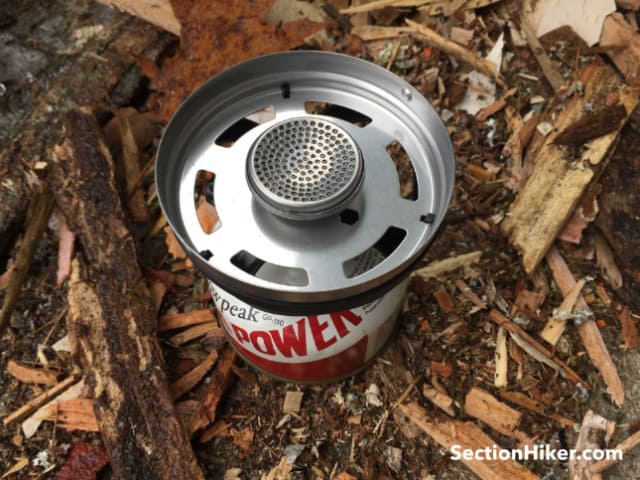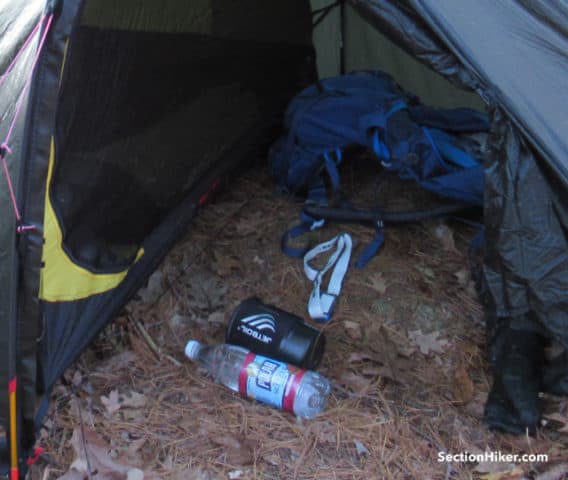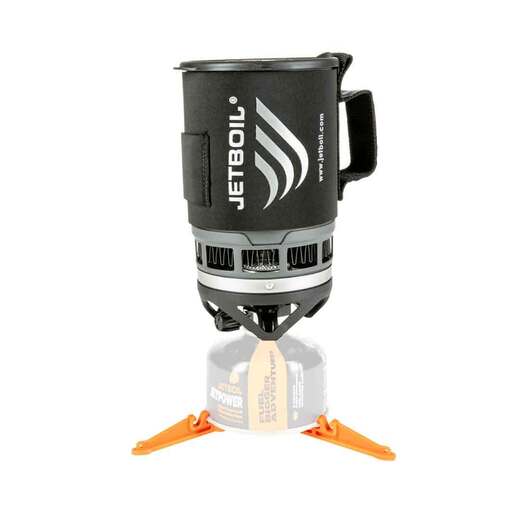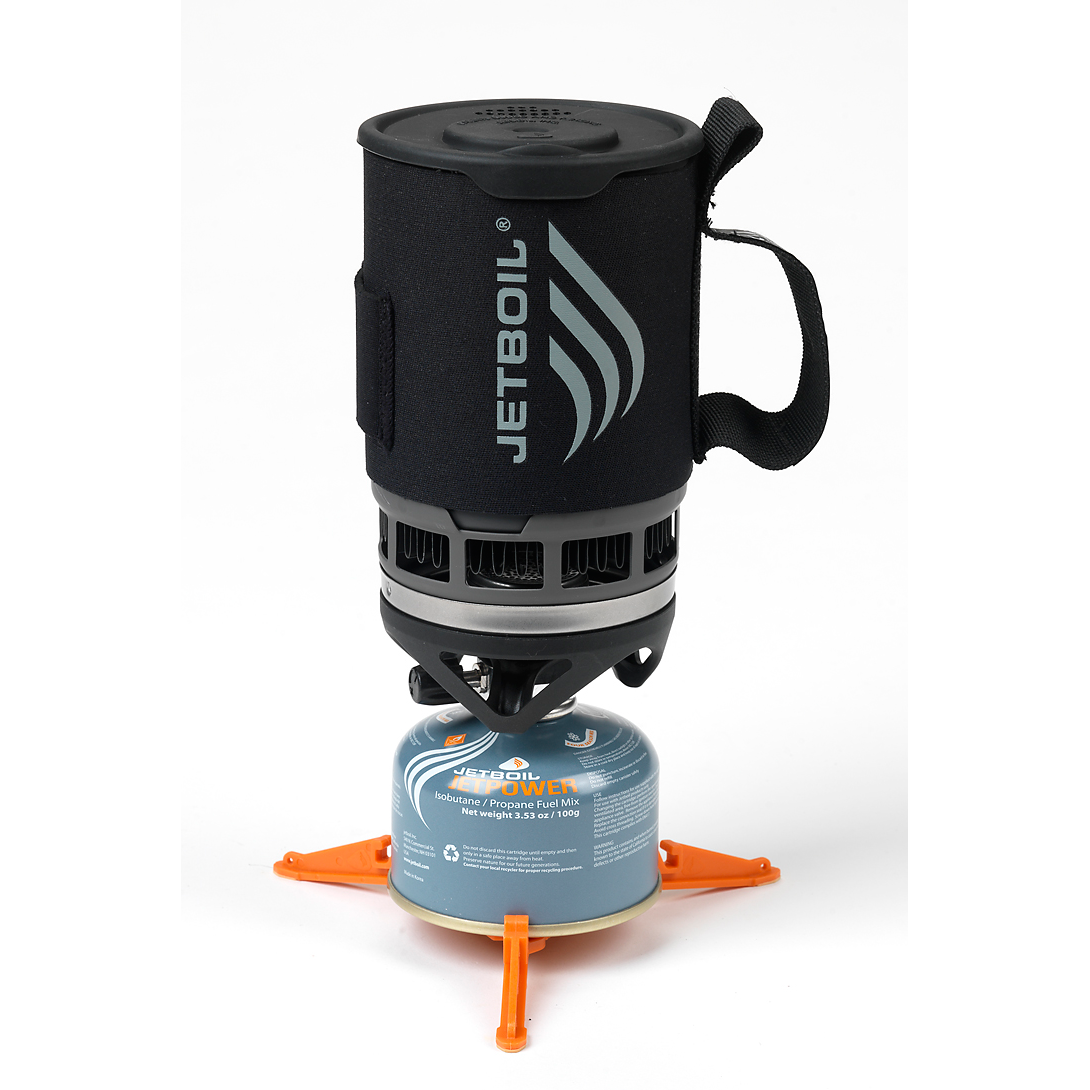The Jetboil Zip is a complete canister stove system that includes an insulated cooking pot, top lid, stove burner, measuring cup, and stand. It’s large enough to carry a small-sized 100 g canister inside and packs together into a small and compact unit that’s easy to carry in a backpack. The Zip is designed to boil water so you can rehydrate freeze-dried or dehydrated backpacking meals and make hot drinks. Sized for a single person, it’s a complete, but bare-bones stove system that’ll get the job done for three season use. The value of this product is in the tight integration of its components and its small size, which makes it easier to pack.
Jetboil Zip Cooking System
Fuel Efficiency
Weight
Time to Boil
Ease of Use
Easy to Pack
Compact and Efficient
Specs at a Glance
- 0.8 liter cook pot and cozy
- Weight: 12 oz (without stabilizer)
- Material: aluminum
- Stove BTUs: 4500
- Pressure regulator: no
- Piezo ignition: no
- Boil time: 2 m 30 sec per 0.5 liter (on average)
- Water boiled: 12 liters per 100 g Jetpower fuel canister (24 x 0.5L boils)
Boiling Water
The Jetboil Zip is really good for heating up water fast. In fact, that’s all it’s really good for. If all you need to do is boil water for drinks, re-hydrate freeze-dried, or home-packaged freezer-bag meals, the Zip will work admirably for your needs. I’d guess that describes 95% of the backpacking population, which explains why this stove is so popular.
The Zip is not designed to simmer or fry food, although I’m sure it’s been done. The valve that feeds gas into the stove has a short black plastic knob that is hard to grasp while the stove is on or to finely control the flame size. Other Jetboil stoves systems, such as the Jetboil Flash, Jetboil MicroMo, and Jetboil MiniMo have a longer wire handle that is safer and easier to turn while the stove is running.
The Zip is also limited by the amount of water you can boil at a time since it has a small 0.8-liter pot. Even then, you’ll be limited to boiling about a half liter (16 oz) at a time to prevent a dangerous boilover. On the flip side, the Zip can boil a 1/2 liter of water quite fast, in 2 min 30 sec on average. If you need more water, you simply boil it.

Jetboil Zip Stove
The Zip’s stove is pretty bare-bones compared to the other system stoves in the Jetboil product line (see below). For example, it doesn’t have a push-button piezo igniter, so you’ll need to light your stove with matches, a lighter, or a sparker. Piezo igniters have a tendency to fail over time, so not having one isn’t a huge loss.
While the Zip can boil water relatively fast, the stove is only rated for 4500 BTUs, compared to the much faster and more expensive Jetboil Flash, which is a 9000 BTU stove. The Zip also doesn’t have a pressure regulator, like the Jetboil Sumo, Jetboil MicroMo, or Jetboil MiniMo. A pressure regulator helps ensure that the size of flame stays the same, even as the contents of a canister are used up. It’s a nice-to-have feature, especially for colder weather, but not an essential if you backpack and camp in warmer weather. Worst case, you’ll need to wait longer for your water to boil when your fuel canister gets close to empty. That’s not the end of the world, either.
The base of the stove has a Lindal B188 valve that screws onto threaded isobutane gas canisters. Most of the fuel canisters you can buy in the US are compatible with a Lindal valve including Jetboil JetPower Fuel, MSR IsoPro, and Snow Peak Gigapower Fuel.

Jetboil Zip Pot
The Zip’s pot is made with aluminum and is wrapped in an insulated neoprene cozy to conserve heat and fuel. The cozy also has a webbing handle so you can safely grip the pot and pour from it. The top of the pot has a black plastic lid perforated with a pour spout and colander holes. It fits rather well and will stay closed inside your backpack.
If you want to cook noodles in a Zip, the best way to do it is to bring your water to a boil, turn off the stove, drop in your noodles, cover the top and let them rehydrate. There’s no need to simmer ramen noodles or pasta, which can simply cook by soaking (See Forget Boiling: How to Cook Dried Pasta and Stretch Your Stove Fuel)
The interior of the pot has etched fluid measurements in milliliters (max of 500 ml ) and ounces (max of 16 oz). The base of the pot also has flanges that lock onto the stove when the burner is in use. This ensures an optimal distance between the flame and the bottom of the pot, while helping to prevent the pot from being accidentally knocked off the stove.

The bottom of the pot has heat retention fins that retain heat that would otherwise be lost after the flame has come into contact with the pot, and provide a modest amount of wind protection. They’re surrounded by a reinforced cage, which locks onto the stove with specially shaped flanges, when used.
Jetboil Zip Cup
The Jetboil Zip comes with an 8 oz plastic measuring cup that can be used as a drinking cup or bowl. It snaps onto the bottom of the pot when packed and has fluid measurements on the inside. This measuring cup is not made with the most durable plastic and it is easy to lose. I know this from experience. I cracked both of the cups that came with my last two Jetboils and stopped carrying them with the stove. If you’re comfortable eating and drinking directly from the cook pot, there’s no need to carry the additional cup.

Jetboil Stabilizer
Canister stoves systems, by their nature, can be tippy. So Jetboil includes an orange pot stabilizer with the Zip that snaps onto small or large fuel canisters. The stabilizer legs fold up neatly, so you can store it in the pot with a 100-gram fuel canister and the stove when you pack the Zip up.
The stabilizer is another component that you can leave at home if you’re careful, although it helps to fill in the space it takes in the cook pot to reduce any rattling when you’re hiking.
Jetboil Cook Systems Comparison
| Make / Model | Weight | Pot Volume | Piezo Ignition | Regulator | Boil Time* |
|---|---|---|---|---|---|
| Jetboil Zip | 12 oz | 0.8L | No | No | 2:30 |
| Jetboil Flash | 13.1 oz | 1L | Yes | No | 1:40 |
| Jetboil MicroMo | 12 oz | 0.8L | Yes | Yes | 2:15 |
| Jetboil MiniMo | 14.6 oz | 1L | Yes | Yes | 2:15 |
| Jetboil Sumo | 16 oz | 1.8L | Yes | Yes | 2:08 |
Recommendation
The Jetboil Zip Cooking System boils water quickly and efficiently for making hot drinks or rehydrating pre-packaged backpacking meals. While it lacks the features of Jetboil’s more expensive cooking systems, it’s perfectly sufficient for multi-day backpacking trips or thru-hikes. Compact, lightweight, and self-contained, the pot is large enough to store a 100 g fuel canister together with the stove and accessories so you can stay organized on trips. If you need to cook for multiple people or want to be able to cook more complex 1-pot meals, you’d be better off getting a higher volume Jetboil cooking system or cook pot (since Jetboil components are interchangeable) because they can hold more liquid.
Compare 4 Prices
-
 REI$99.95View
REI$99.95View -

 Amazon US$99.99View
Amazon US$99.99ViewAmazon.com Price: $99.99 (as of 04/22/2024 06:48 GMT-0400) Details
Product prices and availability are accurate as of the date/time indicated and are subject to change. Any price and availability information displayed on Amazon.com at the time of purchase will apply to the purchase of this product.
-

 Sportsman's Warehouse$99.99View
Sportsman's Warehouse$99.99View -

 Eastern Mountain Sports$99.99View
Eastern Mountain Sports$99.99View
Disclosure: The author purchased this stove.
SectionHiker is reader-supported. We only make money if you purchase a product through our affiliate links. Help us continue to test and write unsponsored and independent gear reviews, beginner FAQs, and free hiking guides. SectionHiker.com Backpacking Gear Reviews and FAQs
SectionHiker.com Backpacking Gear Reviews and FAQs 

Thanks for another helpful review. I’d welcome a comparison (perhaps you already have done one) between Jetboil type systems and MSR pocket rocket type systems. I’ve long used a Jetboil which has suited me year round for hiking in the Whites. I would put the fuel in a jacket/sleeping bag and it would always work no matter the low temps. For my recent AT thru hike I was concerned about the bulk and weight so I went with a MSR pocket rocket and a Toaks titanium container. I used that for most of the hike and by the time I got to New England I didn’t want any extra weight in my pack and ditched that too. From then on I cold soaked ramen and even mountain house meals.
On the AT, I always admired the Jetboil systems for working more simply, faster and more fuel efficiently than the pocket rocket setups. Those lucky folks who had the Jetboil titanium models were envied, all the more so since it’s no longer available:(
I think it comes down to durability. An MSR stove system will last forever. A Jetboil: You’re lucky if you get it to last 50-100 uses before its starts to fall apart. Gas pressure in cold weather is largely a function of canister temperature (physics). Boil speed is a function of stove BTUS (which vary from stove to stove). Both have decent wind resistence. Actually the Jetboil is kind of a marvel in this regard considering the hoops that the Reactor has to jump through with a radiant burner.
Besides the rapid boiling times, I never really understood the widespread appeal for the JetBoil system. It’s larger, heavier, way more expensive, and far less flexible than my $7 Chinese pocket rocket ripoff that has served me without flaw for five+ years. In colder weather I switch to a Kovea Spider so I can flip the canister. That system is also smaller, lighter, less expensive, and far more flexible than the Jetboil system. I like switching between ultralight cook pots or adding a tiny fry pan depending on the trip. Both of these stoves allow me to do that. I wonder if Jetboil owners could chime in about why they prefer it over other types of stoves.
I use a Jetboil for car camping, cabin camping or base camping since it is extremely efficient. I no longer use it for backpacking, for the same reasons you cite. Many backpackers do, however, trading the added weight for the simplicity, reliability, and efficiency of a Jetboil.
I got my new MiniMo for $85 @REI. It is a little heavy but still less than a pound. I don’t spend a lot of time cooking when I backpack. It is fast and efficient at boiling which is good enough for me.
The Zip has been my go to pot for probably 6 years now. It’s simple, cheap(er) and small – perfect for simple meals for one and small enough to tote around on day hikes to enjoy a hot tea or coffee.
If I’m going to bring a stove, this is the one. Never saw a need to bring anything else, but then I leave the gourmet cooking for off-trail.
Almost at the same time as Philip was on the Cape Wrath Trail, I walked the TGO Challenge in Scotland, with, thankfully, a successful crossing!. Over years of backpacking, I have collected and used many, many stove/fuel combinations, however, I still return to a modified Jetboil Zip as my go-to stove and have done in it’s original and modified form for over five years. Modified sounds dangerous but all I have done is swapped out the original burner for a Minimo regulator, removed the plastic cup, swapped out the plastic lid for a one from an Alpkit 650ml Ti pot and put the whole combination in a custom Cuban bag. This is still one of the most fuel-efficient stove combinations out there. I rehydrate my food 99% of the time and use it as a brew kit. It works for me. This was proved by using only 2 small gas canisters over the whole 2-week trip and I still came back with 15% in the seconds one!